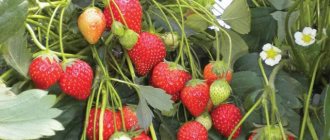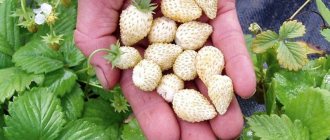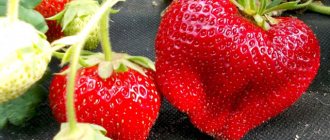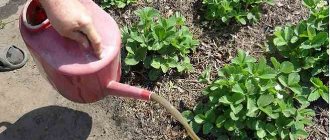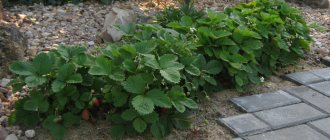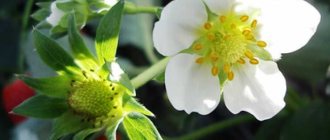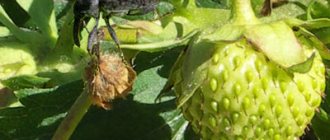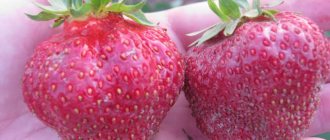Monterey is a fairly new remontant variety of garden strawberry. It was released in the United States of America in 2001. To obtain Monterey, the Albion variety was used (the best specimens were selected: cal. 27−85.06).
Over the course of several years, the resulting samples were improved and tested. As a result, the final version was presented in 2009, called Monterey. At the same time, garden strawberries were patented.
From Albion, Monterey inherited all its best qualities. For example, if we talk about yield, Monterey shows 35% better performance than its parent. In addition, Monterey does not have the main disadvantage of Albion - its berries are not so hard.
In today's publication you will learn a detailed description of the American variety of garden strawberries, read reviews from gardeners, and also see photos of its berries.
Origin and official registration
The Monterey variety was bred in 2001–2002 by specialists from the University of California (USA), officially registered as a trademark, and has an American patent (PP19767, 2009). It is called an improved version of “Albion” (obtained as a result of crossing with the subspecies Cal 97.85-6), superior to its popular “parent” in terms of yield (the gross yield is 35% higher) and the commercial qualities of the berries.
Compared to "Albion", the berries of the "Monterey" variety are larger in size and have a delicate (not crunchy) pulp texture
There is no information about the variety in the State Register of the Russian Federation yet, but in 2014 it was included in the Belarusian register as approved for cultivation throughout the country. “Monterey” is undemanding to soil types, successfully adapts to the continental climate: winter-hardy, relatively resistant to drought, spring and autumn frosts, and therefore provides high marketable yields in open ground. The variety shows excellent results when cultivated in greenhouses and even at home, where it can bear fruit all year round.
Growing and care
For garden strawberries, choose a well-lit place; the sun should hit the beds, based on the characteristics, for at least 6 hours.
When planting remontant Monterey strawberries, you need to take into account the 40x50 scheme: thickened plantings lead to a decrease in yield. The wells are filled with water in advance and a little Kornevin is added. If ordinary beds are used, then the surface of the ground under the strawberry bushes needs to be mulched.
Otherwise, growing and caring for Monterey strawberries is not much different: loosening the soil, watering, weeding, protection from pests. Since the remontant variety produces crops several times a year, it is especially demanding when it comes to fertilizing. It is best to water Monterey strawberries using a drip system, and introduce fertilizing through it.
Care is simple, but the Monterey garden strawberry variety is heat-loving and requires shelter for the winter even in the southern regions. Plants are usually covered with spunbond or mulch.
Warning! In regions with harsh climates, the Monterey variety is best grown in a greenhouse.
Features of fruiting
The variety is classified as mid-early or mid-ripening, since, depending on weather and climatic conditions and agricultural cultivation techniques, the first wave of fruiting begins at the end of May or the second or third decade of June.
Powerful tall Monterey strawberry bushes bloom in early May
During the season, the plants manage to produce 3-4 waves of harvest, with the berries of the first harvest being the largest, and the berries of the second peak, occurring in July, having the most pronounced taste and aroma. During hot or dry periods, the berries may turn red too quickly, not having time to gain the proper size and taste. Monterey strawberries, according to gardeners, continue to bear fruit until late autumn (in some regions until the end of October - mid-November).
Intense flowering and filling of berries are observed not only on the main plants, but also on daughter rosettes 2-3 months old.
The bushes themselves are powerful, tall (up to 35-40 cm in height and diameter), medium-leafed, with a developed root system. The mustache grows in moderate amounts. The leaves are large, almost vertical, with long, densely pubescent petioles, light to bright green, glossy, concave. There are 7–14 flower stalks on the bushes; they are thick and strong, with multi-flowered inflorescences. The flowers are large, white, bisexual, with a large supply of pollen; barren flowers are practically absent.
Reproduction methods
How to choose female sockets:
The Monterey strawberry variety begins to bear fruit in the second year; after a year and a half, the yield decreases. Therefore, it is necessary to take care of planting material. Remontant garden strawberries of this variety can be propagated in any way: seeds, tendrils, root division (the most successful option for the Monterey variety).
Planting material obtained from seeds does not bear fruit in the first year after planting. As for propagation by mustaches, it should be noted that the Monterey strawberry variety produces them in minimal quantities, because all the plant’s energy goes into creating a rich harvest. The planting material from the mustache is healthy; the rosettes can be rooted in plastic cups or cassettes. Strawberry seedlings with a closed root system have a 100% survival rate.
Attention! Seedlings obtained from rooted tendrils or by dividing the mother bush bear fruit in the year of planting.
Timely replacement of Monterey strawberry bushes allows you to get rich harvests for several years in a row.
Secrets of mustache propagation on video from gardeners:
Consumer qualities of berries
The berries are large in size, weighing on average about 30 g, very even in size and shape - cone-shaped, short (options: biconical, slightly flattened symmetrical, sometimes double). The fruits are bright red outside and inside; when fully ripe, they acquire a dark shade (burgundy or cherry), with a slight shine. The seeds are yellow (sometimes dark red), located on the surface or slightly embedded in the pulp.
In appearance, Monterey strawberries (pictured) are similar to Albion, but their flesh is noticeably darker in color and more aromatic
Most gardeners rate the taste as excellent: balanced, richly sweet with little noticeable sourness, pronounced aroma. According to the originator, the taste is good – 3.4 points (out of 5).
Excessive or insufficient moisture has almost no effect on the sweetness and density of the berries.
Despite the delicate and juicy texture of the pulp, the berries are quite dense, so they are not damaged during harvesting (tear type - dry) and transportation, and retain their shape well during processing and freezing. They are considered universal for culinary purposes. The yield of a variety depends on many parameters, but on average 0.5-1 kg is obtained from a bush per season, and the maximum is about 2 kg.
With a high level of agricultural technology, the harvest can reach 2-2.5 kg of berries per bush per season
Harvest and storage
Monterey berries are harvested up to four times a season, starting in May and ending in October. The fruiting time of the crop is 10–14 days. Strawberries are removed as they ripen by hand, tearing them off along with the stalks. It is better to harvest in the morning or evening, since in sunny weather the berries lose their strength and become lethargic.
The collected berries are sorted, rotten, wrinkled and damaged ones are discarded. Dense ripe fruits are placed in wooden containers in several rows. Since strawberries have a fairly dense structure, they do not lose their presentation, do not leak juice or become deformed. Store the harvest at a temperature of 0...+5°C in the refrigerator for two weeks.
Monterey strawberries, despite some capriciousness in care, are great for both experienced gardeners and beginners. The variety consistently bears fruit even in poor climatic conditions, is characterized by strong immunity, and with proper implementation of basic agrotechnical techniques, it can please you with a decent harvest of juicy, healthy and aesthetically attractive berries.
Sustainability
According to the results of studies conducted in California, the resistance of Monterey strawberries to diseases is higher than that of other varieties:
| Disease | Degree of sustainability (on a 5-point scale) |
| Late blight root rot | 3,2 |
| Verticillium wilt | 3,4 |
| Anthracnose | 2,6 |
Plants are also slightly susceptible to leaf spot and strawberry mite damage, but are moderately susceptible to powdery mildew.
History of growing Monterey strawberries
Monterey garden strawberries, which are more commonly called strawberries, were bred in the USA by scientists at the University of California in 2001. The ancestor of the variety is the hard-fruited Albion strawberry, crossed with selection number cal. 27–85.06.
Two years after testing in Watsonville, in 2009, Monterey strawberries were registered as a separate variety and became widespread in temperate climates - in Europe, Belarus, Russia and Ukraine.
Agrotechnical recommendations
"Monterey" is called a promising commercial variety that requires care. Its potential is manifested with stable watering, complete fertilizing with organic and complex mineral fertilizers, and preventive treatments against diseases and pests.
Planting material for this variety is offered by many domestic and foreign manufacturers.
The variety is propagated mainly using daughter rosettes. The resulting seedlings take root well and quickly. When planting them, it is important to leave sufficient distance between plants (35-40 cm in rows and 50-60 cm between rows), given the large size of the bushes. "Monterey" does not respond well to thickened plantings and shading. Despite the increased (compared to other American varieties) frost resistance of this strawberry, experts advise making winter shelter for the bushes from spruce branches or other organic mulch, spunbond. If the spring turns out to be cold, then to speed up fruiting, arcs are installed over the beds, on which film or agro-fabric is stretched.
Diseases and pests, methods of control and prevention
To avoid infection of strawberries with powdery mildew, you need to properly prepare the area for planting and carry out preventive treatments on time. To begin with, remove all affected parts of the plant, including berries. After which the soil is thoroughly sprayed with chemicals.
Folk remedies will help get rid of the nematode:
- Before planting the plantation, treat the ground with saline solution. It is prepared at the rate of 5 tbsp. l. salt per 5 liters of water.
- In early spring, spray the strawberries with a 1% solution of Bordeaux mixture over a green cone.
- Apply organic matter and manure regularly.
In addition, it is necessary to observe crop rotation and not plant strawberries after potatoes. To treat the area, you can use chemicals that are diluted in accordance with the instructions.
Reviews
Arina, 38 years old, Bendery
I've heard a lot of praise about Albion strawberries before, and recently I found out that there is an improved version - Monterey. Although this is a variety of Californian origin, where a subtropical climate prevails, it is not too capricious. It has proven itself to be quite winter-hardy and has calmly withstood frosts in spring and autumn. In summer, it responded to drought less than other remontant varieties and practically did not slow down its fruiting. We started picking berries from the first days of summer, and finished in late autumn. Of course, the early and late ones are not as sweet and aromatic as at the height of summer, but they are still very pleasant to taste. The consistency is moderately dense and juicy, and does not fall apart during cooking. It makes excellent jam and compotes. I was pleased with the yield - almost a kilogram of berries was harvested from each bush during the season. It was enough to eat and do all the winter preparations.
Semyon, 57 years old, Oryol region.
I was not impressed with American strawberry varieties. Of course, they win in terms of productivity and appearance of berries, but it only makes sense to grow them for sale. For example, “Monterey” has berries just like in the picture, neat, clean, even, almost all of the same large size. But the taste is very mediocre, and the aroma is not special. Constantly bearing bushes also require regular care. Plants use up their strength in 2-3 years, then it is better to renew the plantings. In general, such varieties are not very suitable for beginners or “lazy” gardeners like me.
Features of the variety, pros and cons
The Monterey variety differs from other types of strawberries in its cultivation method. A larger area is allocated than in other cases, since the bushes quickly grow and become strong and powerful. By making large distances between bushes in advance, you can avoid crowding.
This strawberry has many positive qualities, here are some of them:
- high yield;
- tender, sweet berries, which at the same time have a hard shell;
- fruits retain a presentable appearance for a long period and are suitable for long-term transportation;
- the shape of the berries is preserved when frozen, after defrosting the fruits are just as elastic and juicy;
- taste qualities do not depend on the amount of moisture;
- there is no excessive amount of whiskers, so there is no need to remove them;
- berries are used at home and in industrial conditions
The list of shortcomings is short:
- if the bushes are allowed to become dense, the plant dies;
- In hot climates, the berry turns red ahead of time and does not have time to gain the required weight.
- poor frost resistance.
- Rejuvenation of plantings is required annually; every two to three years it is advisable to replant the strawberries to a new area.
If you read consumer reviews, you can often hear positive statements.
We invite you to watch an interesting video about Monterey strawberries:
Nuances of plant care
Caring for Monterey is traditional, like most remontant varieties of berries. Fertilizing, weeding, loosening, carrying out preventive measures to protect plants from pests and diseases.
Weed control
Strawberry plantings must be loosened periodically, the optimal depth is 3 cm. The roots of the plant must be ventilated and receive oxygen. The loosening process is combined with the removal of weeds. It is imperative to remove weeds; they take away nutrition from the berries and can be carriers of diseases. In early spring, it is important to clear plants of debris, old leaves and winter coverings in the form of mulch. This will release the young buds, and the plant will quickly gain strength for growth.
Top dressing
Strawberries bear fruit all season long, but the soil is quickly depleted. Fertilizers must be applied regularly. Feeding with cow pats and bird droppings is a proven method. The main thing is not to “burn” the plants, be sure to follow the dosage. Mineral fertilizers used include nitrophoska, urea, superphosphate, and wood ash.
Watering
Drip irrigation is the best way to moisten the soil and leaves of plants; fertilizers can be introduced through it. If there is excess moisture, strawberry roots may begin to rot, but the taste and structure of the fruit will not deteriorate, and the berries will not become watery. This feature is genetically determined by breeders.
Plants should be watered 3-4 times a week. If strawberries are grown in open ground, then only in the evening or early in the morning.
Wintering
Opinions about the frost resistance of berries vary. Manufacturers claim that the plant is relatively frost-resistant. Monterey does not require additional shelter for the winter at temperatures not lower than -25 C. But experienced gardeners cover strawberries of this variety for the winter using film or covering material.
Basic care recommendations: watering, fertilizing
Care includes the following manipulations.
| Loosening the soil | This manipulation helps the penetration of air into the soil to the root system. Loosening promotes proper plant growth. |
| Watering | Monterey strawberries like regular watering, especially if the temperature outside is high. Thanks to the large amount of liquid, the strawberries become juicy. |
| Introduction of fertilizers | Organic and mineral substances are used as fertilizing. Feeding and soil enrichment are also carried out regularly. Substances that are necessary for the growth of the berry are introduced monthly. |
| Getting rid of weeds | Weeding is carried out regularly after watering. If you do not weed and remove weeds, the soil becomes depleted, resulting in small fruits. |
| Protecting bushes from the sun | You can cover the plants with agrofibre on top or use straw as mulching. |
| Eliminate pests and diseases | Although the variety is not susceptible to insect attacks, it is still recommended to regularly inspect the foliage in order to promptly eliminate parasites or detect the first signs of disease |
If you do not follow these recommendations, this will negatively affect the yield and taste of the product.
Selection and preparation of soil for planting
Before planting, you should carefully select a location and prepare the soil. Basic requirements for the site:
- flat area;
- fertile land;
- absence of drafts;
- south or well-lit side;
- convenience for watering.
The planting site is selected without a slope, so that the entire surface is well lit - there is free access to direct sunlight for at least six hours a day.
Monterey does not grow on rocky, clay or marshy soils. A location on a slope is not suitable for this variety. In this case, it will be impossible to install a drip irrigation system due to the fact that when watering, all the water will flow to the lower part of the site. The area must be cleared of weeds and disinfectants applied.
Before planting, the selected location should be treated for weeds.
For high yields and good development of bushes, moderate black soil is required, with a small amount of sandy inclusions. Acidic soil with a high limestone content is also not suitable.
